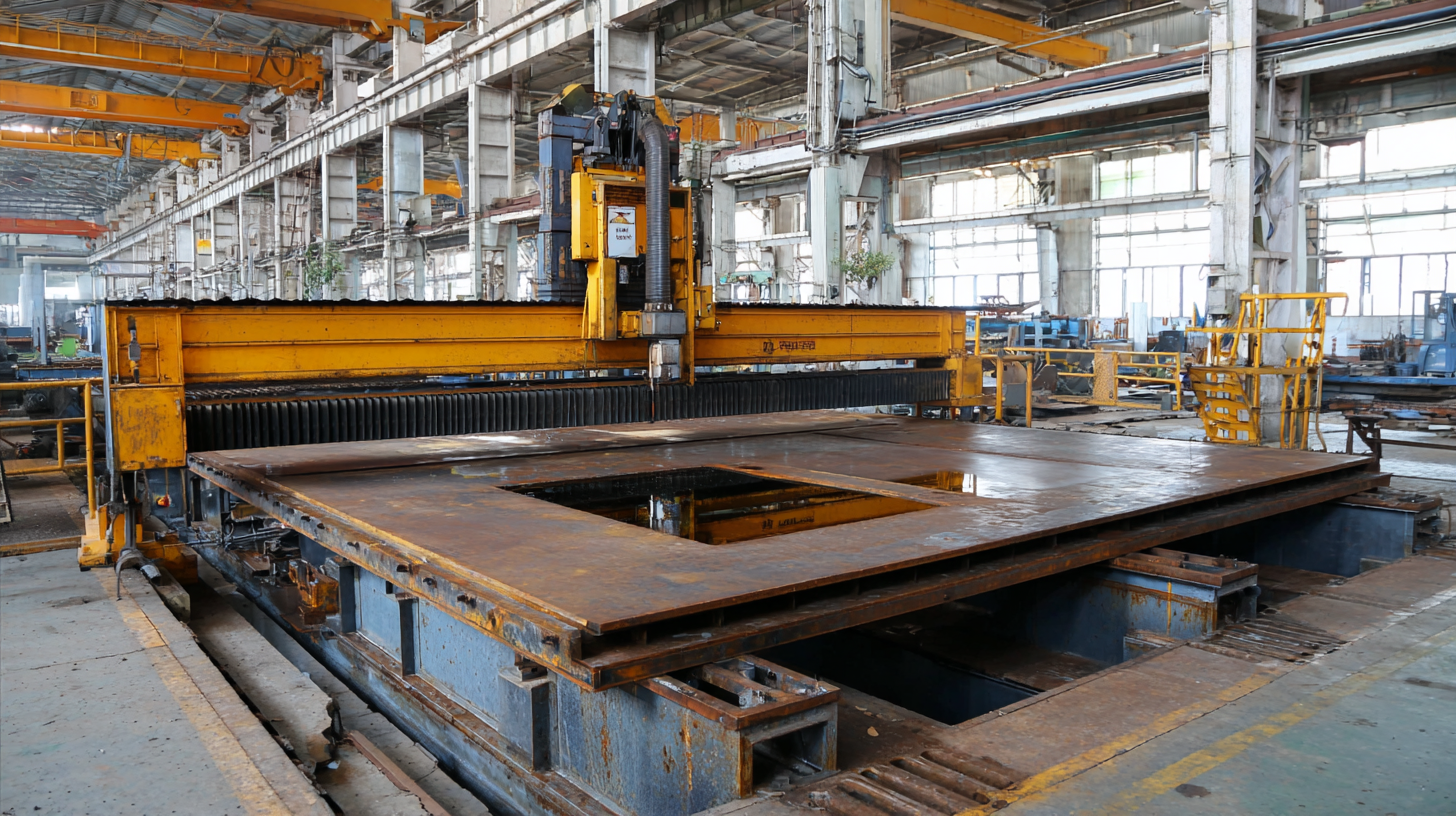The Future of Precision with CNC Plasma Cutting Tables in Manufacturing
As the manufacturing industry continues to evolve, the integration of advanced technologies is paving the way for unparalleled precision in production processes. Among these innovations, the CNC plasma cutting table stands out as a critical tool that enhances efficiency and accuracy. According to a recent report by MarketsandMarkets, the global CNC machine market is expected to reach $117.1 billion by 2025, with plasma cutting technology playing a significant role in this growth. The precision and adaptability of CNC plasma cutting tables allow manufacturers to achieve intricate cuts and complex designs with remarkable speed, reducing both operational costs and material waste. This blog will explore the future of precision in manufacturing through the lens of CNC plasma cutting tables, highlighting how they are transforming traditional practices into streamlined, high-tech processes.

The Evolution of CNC Plasma Cutting Technology in Modern Manufacturing
The evolution of CNC plasma cutting technology has significantly transformed the landscape of modern manufacturing. Initially developed for its speed and efficiency, CNC plasma cutting has progressed from simple manual operations to sophisticated automated systems. Today’s machines utilize advanced software that allows for intricate designs and precise cuts, making it easier for manufacturers to meet stringent quality standards.

Moreover, advancements in technology have made CNC plasma cutting tables more accessible and user-friendly. With the integration of computer-aided design (CAD) and computer-aided manufacturing (CAM) software, operators can now create complex geometries with ease. This not only speeds up the production process but also reduces material waste, contributing to a more sustainable approach in manufacturing. As industries continue to embrace these innovative technologies, CNC plasma cutting is poised to play a crucial role in shaping the future of precision manufacturing.
Key Advantages of Using CNC Plasma Cutting Tables in Production
The advent of CNC plasma cutting tables has revolutionized the manufacturing sector, offering unparalleled precision and efficiency in cutting various materials. One of the key advantages of utilizing these advanced systems is their ability to produce intricate designs with minimal waste. Traditional cutting methods often result in excess material being discarded, but CNC technology maximizes resource utilization, making production processes more sustainable and cost-effective.
Additionally, CNC plasma cutting tables enhance productivity significantly. With their automated features, these machines can operate continuously, reducing the need for manual intervention and allowing for quicker turnaround times. This not only accelerates project completion but also permits manufacturers to take on more jobs simultaneously, increasing overall throughput. Furthermore, the software-driven operation allows for adjustments and programming to be made swiftly, ensuring that manufacturers can respond promptly to changing market demands without compromising on quality. This combination of precision and efficiency is reshaping the landscape of modern manufacturing, demonstrating why CNC plasma cutting tables are becoming an essential tool in production facilities.
The Future of Precision with CNC Plasma Cutting Tables in Manufacturing - Key Advantages of Using CNC Plasma Cutting Tables in Production
| Advantage | Description | Impact on Production |
|---|---|---|
| High Precision Cutting | CNC plasma cutting provides high accuracy within tight tolerances, improving the quality of cuts. | Reduces waste and rework, leading to lower costs. |
| Increased Speed | CNC plasma cutting is significantly faster than traditional cutting methods. | Shorter lead times, allowing for quicker project turnaround. |
| Versatility in Materials | Can cut a variety of materials including metals, plastics, and composites. | Broader application range, catering to diverse industrial needs. |
| Reduced Labor Costs | Automation reduces the need for manual cutting, minimizing labor expenses. | Allows reallocation of skilled labor to more critical tasks. |
| Safety Features | CNC machines come with built-in safety protocols to prevent accidents. | Safer work environment, reducing injury rates. |
Exploring Industry Applications of CNC Plasma Cutting Techniques
CNC plasma cutting technology has revolutionized various industries by offering precision and efficiency in metal cutting applications. One prominent sector benefiting from this advancement is automotive manufacturing, where intricate designs and high-strength materials are essential.
 CNC plasma cutting tables allow for rapid prototyping and efficient production of parts, reducing lead times and enhancing the overall workflow. The ability to produce complex shapes with high accuracy means manufacturers can meet stringent design specifications while maintaining cost-effectiveness.
CNC plasma cutting tables allow for rapid prototyping and efficient production of parts, reducing lead times and enhancing the overall workflow. The ability to produce complex shapes with high accuracy means manufacturers can meet stringent design specifications while maintaining cost-effectiveness.
Another area seeing significant adoption of CNC plasma cutting techniques is the construction industry. With the growing demand for custom metal structures, this technology enables architects and builders to realize their visions without compromising on quality. The versatility of CNC plasma cutting tables permits the handling of various materials, including steel, aluminum, and copper. This adaptability not only supports the construction of unique designs but also improves structural integrity by minimizing waste and optimizing material usage. As industries continue to push for innovation, CNC plasma cutting will undoubtedly play a vital role in shaping the future of manufacturing.
Future Trends: Advancements in CNC Plasma Cutting for Precision Engineering
The advancements in CNC plasma cutting technology are paving the way for increased precision in engineering applications. As industries across the globe adopt digital manufacturing techniques, the demand for high-precision tools is surging. The evolution of CNC machines is significantly driven by innovations that emphasize increased accuracy and efficiency, enabling manufacturers to meet stringent quality control standards. With a reported growth in the CNC machine tools market, we can expect more multi-axis and high-precision machining centers to emerge, transforming production capabilities in various sectors.
Tips for maximizing precision with CNC plasma cutting include ensuring regular maintenance of equipment to optimize performance, calibrating machines frequently to maintain accuracy, and utilizing high-quality plasma cutting consumables that can enhance the precision of cuts. Additionally, integrating software solutions that utilize Artificial Intelligence can further refine the cutting processes, allowing for real-time adjustments based on material properties and cutting conditions.
As we look to the future, emerging trends indicate an increasing reliance on smart technology in CNC machining environments. The incorporation of AI and robotics not only boosts productivity but also streamlines precision engineering tasks. By staying informed of these trends and investing in the latest technologies, manufacturers can stay competitive in an ever-evolving market that hinges on precision and efficiency.
Integrating Automation and AI into CNC Plasma Cutting Workflows
The integration of automation and artificial intelligence (AI) into CNC plasma cutting workflows is revolutionizing the manufacturing industry. As manufacturers strive for greater efficiency and precision, the use of advanced automation technologies allows CNC plasma cutting tables to operate at unprecedented speeds and with greater accuracy. Automated systems can optimize cutting paths, reduce waste, and ensure consistent quality, which is critical in today’s competitive market. The adaptability of these systems means they can run a variety of materials and handle complex designs with ease, enhancing productivity across multiple sectors.
AI further enhances the capabilities of CNC plasma cutting by enabling smart decision-making. Machine learning algorithms can analyze data from previous cuts to identify patterns and recommend adjustments for improved performance. This data-driven approach minimizes human error, ensuring that each cut is executed perfectly. Moreover, predictive maintenance powered by AI can foresee potential issues before they become significant, allowing for uninterrupted production and reduced downtime. The synergistic effect of automation and AI is setting new benchmarks in manufacturing efficiency, positioning CNC plasma cutting as a cutting-edge solution for modern industrial needs.
The Future of Precision with CNC Plasma Cutting Tables in Manufacturing
This bar chart illustrates the growth of precision in CNC plasma cutting technologies over recent years, showing the increasing integration of automation and AI in manufacturing workflows.

